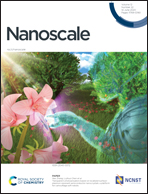Transparent, flexible MAPbI3 perovskite microwire arrays passivated with ultra-hydrophobic supramolecular self-assembly for stable and high-performance photodetectors†
Abstract
The emergence of organic–inorganic hybrid perovskites (OHPs) has revolutionised the potential performance of optoelectronic devices; most perovskites are opaque and hence incompatible with transparent optoelectronics and sensitive to environmental degradation. Here, we have reported a single-step fabrication of ultra-long MAPbI3 perovskite microwire arrays over a large area using stencil lithography based on sequential vacuum sublimation. The environmental stability of MAPbI3 is empowered with a newly designed and synthesized transparent supramolecular self-assembly based on a mixture of two tripodal L-Phe-C11H23/C7F15 molecules, which showed a contact angle of 105° and served as ultra-hydrophobic passivation layers for more than 45 days in an ambient atmosphere. The MAPbI3 microwire arrays passivated with the supramolecular self-assembly demonstrated for the first time both excellent transparency of ∼89% at 550 nm and a remarkable photoresponse with a photo-switching ratio of ∼104, responsivity of 789 A W−1, detectivity of 1014 Jones, linear dynamic range of ∼122 dB, and rise time of 432 μs. Furthermore, the photodetector fabricated on a flexible PET substrate demonstrated robust mechanical flexibility even beyond 1200 bending cycles. Therefore, the scalable stencil lithography and supramolecular passivation approaches have the potential to deliver next-generation transparent, flexible, and stable optoelectronic devices.



 Please wait while we load your content...
Please wait while we load your content...